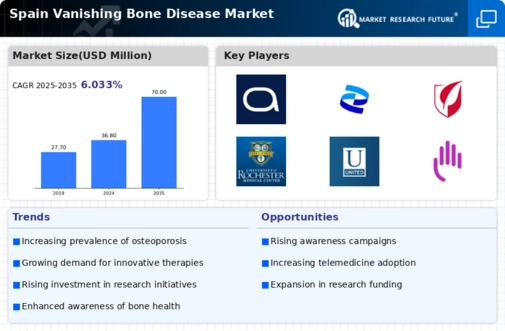Rising Public Health Initiatives
Public health initiatives aimed at raising awareness and improving education about bone health are gaining momentum in Spain. Campaigns focusing on the prevention and management of bone diseases are likely to enhance public understanding of conditions such as vanishing bone disease. These initiatives, often supported by government and non-profit organizations, aim to promote early diagnosis and encourage individuals to seek medical advice. As awareness increases, it is anticipated that more patients will be diagnosed and treated, thereby expanding the market. Additionally, educational programs targeting healthcare professionals are expected to improve the quality of care provided to patients. This growing emphasis on public health is a significant driver for the vanishing bone-disease market, as it fosters a more informed patient population and encourages proactive health management.
Advancements in Medical Technology
Technological advancements in medical devices and treatment methodologies are transforming the landscape of the vanishing bone-disease market. Innovations such as 3D printing for customized implants and advanced imaging techniques for accurate diagnosis are becoming more prevalent in Spain. These technologies not only enhance patient outcomes but also streamline treatment processes, making them more efficient. The Spanish healthcare system is increasingly adopting these innovations, which could potentially reduce treatment costs by up to 20%. Moreover, the integration of telemedicine in patient management allows for continuous monitoring and timely interventions, further driving the demand for effective solutions in the vanishing bone-disease market. As these technologies evolve, they are expected to play a pivotal role in shaping the future of treatment options available.
Increasing Incidence of Bone Disorders
The rising incidence of bone disorders in Spain is a critical driver for this market. Recent studies indicate that conditions such as osteoporosis and osteogenesis imperfecta are becoming more prevalent, particularly among the aging population. This demographic shift suggests a growing need for effective treatments and management strategies. As the population aged 65 and older is projected to reach 9.5 million by 2030, the demand for therapies addressing vanishing bone diseases is likely to increase significantly. Furthermore, healthcare providers are focusing on early diagnosis and intervention, which may lead to a surge in market growth. The increasing burden of these disorders on healthcare systems in Spain necessitates innovative solutions, thereby propelling the vanishing bone-disease market forward.
Growing Investment in Biopharmaceuticals
The biopharmaceutical sector in Spain is witnessing a surge in investment, which is significantly impacting the vanishing bone-disease market. With an estimated €1.5 billion allocated to research and development in 2025, pharmaceutical companies are increasingly focusing on developing novel therapies for rare bone diseases. This influx of capital is likely to accelerate the discovery of innovative treatments, including gene therapies and monoclonal antibodies. Additionally, collaborations between academic institutions and industry players are fostering a conducive environment for breakthroughs in treatment options. The potential for high returns on investment in this niche market is attracting more stakeholders, thereby enhancing the overall growth trajectory of the vanishing bone-disease market. As these investments materialize, they are expected to lead to a wider array of therapeutic options for patients.
Regulatory Support for Rare Disease Treatments
Regulatory frameworks in Spain are becoming increasingly supportive of the development of treatments for rare diseases, including those affecting bone health. The Spanish Medicines Agency (AEMPS) has implemented expedited approval processes for orphan drugs, which are crucial for the vanishing bone-disease market. This regulatory environment encourages pharmaceutical companies to invest in research and development, as they can bring their products to market more swiftly. Furthermore, incentives such as tax breaks and grants for companies focusing on rare diseases are likely to stimulate innovation. As a result, the availability of effective treatments for vanishing bone diseases is expected to increase, thereby enhancing patient access and improving health outcomes. This supportive regulatory landscape is a vital driver for the growth of the vanishing bone-disease market.























Leave a Comment